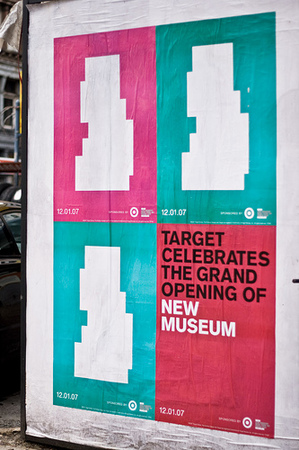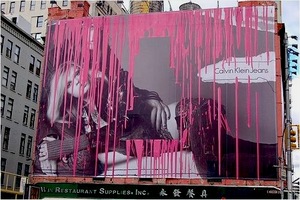This is an archive of the ArtCat Zine, 2007-2009. Please visit our new project, IDIOM.
On the New Museum

Writing in Art on Paper on the occasion of Marcia Tucker’s death, Dan Cameron had this to say about the late curator:
Marcia set a high ethical standard for herself and challenged the art world to follow suit. She always championed the underdog, struggled to articulate art's power to change people's lives, openly deplored the growing commercialization of the New York art community, wholeheartedly rejected the current trend of running museums like corporations, and believed fervently that museum curators should maintain a healthy distance from big-name art dealers. Even if Marcia's principles are no longer pragmatic for running a museum in the twenty-first century, they may yet survive as the perfect blueprint for launching one.
I am interested here in Cameron’s contrast between running a museum and launching one, as the opening of the New New Museum late last year seems to fall somewhere in between. Not quite business as usual, certainly, but also not a totally fresh start, the dual opening — of the architecture and the art — poses an unique opportunity for a re-examination of the relationship between the current presentation and its institutional history. Which New Museum is it that opened on the Bowery to so much fanfare?
I do not wish to speculate as to whether or not the New New Museum (NNM) lives up to the ethical paradigm ascribed to Tucker by Cameron, if, that is, its launching as a new building is enough to overcome the pragmatic considerations he cites. I’m certain I have no idea; Tucker’s principles could be enumerated, commandment-style, on every new cubicle wall, or mentioning her name could be tantamount to treason, each are equally probable, for all I know, and the truth is probably somewhere in between. What is fascinating is that regardless of the relative importance of these ideas in terms of organizational or pragmatic priority, their legacy can be examined via the considerable branding effort being put forth at every level of the event in question.
We could therefore frame this another way, as a comparison of two blueprints, on the one hand, there is the one already mentioned, attributed by Cameron to Tucker, and the launching of the New Museum, and on the other, there is the brand identity created for the launch of the New New Museum. My claim is twofold, first that both blueprints are organized by, or participate in a certain discourse of authenticity, and, secondly, the appearance of this vocabulary in two distinct aspects of the NNM provide a rare window onto the lexical or symbolic relationship between authenticity as a brand, and a history of authenticity, we might say. Taken apart, neither moment is news; authenticity has been the dominant branding motif for at least fifteen years and, on verso at least, the moral paradigm of choice since the Second World War. Similarly, we have plenty of examples of people, ideas, or institutions who arrive from the past couched in a narrative of having been authentic, if sometimes little else. What is new is that the New Museum (NM), unlike Jeep, Sprite or any other brand offering itself as an emissary of the real, actually possesses a history worthy of the term. And it is a history that it has been careful to honor in terms of the design and execution of its new building and inaugural show. It is in light of this that I would like to suggest one further point, namely that the NNM may be the best example we have so far of the becoming-brand of authenticity, if only because that is quite literally what is taking place, literally the translation of one blueprint into another, as opposed to either the performative contradiction of being told to obey one’s thirst, or pulling a CBGB and never really trying.
Three critical responses to the NNM’s openings approach the ‘brand | authenticity’ question from different angles, and, though none articulate it quite the way I am attempting, each is a good example of the way in which these ideas demand negotiation, even tacitly.
The first is from Inga Saffron’s out-market scolding in the Philly Enquirer, which is worth reading, even after I quote it extensively; pay close attention to the way in which she moves from criticizing the NNM for daring an attempt at authenticity, to criticizing it for actually being inauthentic.
… the New Museum was born to live in perpetual rebellion. After its late founder, Marcia Tucker, was fired from the Whitney Museum of American Art in 1977, she created the start-up to display cutting-edge art hot from the studio, as opposed to the gallery-vetted kind. When the museum decided in 2002 that it needed a home of its own, it sought a spot in the edgiest neighborhood still extant in Manhattan, the Bowery. Edgy is a relative term, of course. As New Yorkers increasingly grumble, Manhattan has virtually exhausted its virgin lands. Although there's hardly a frontier left to gentrify, the myth of the urban pioneer dies hard… Trouble is, there's a Whole Foods up the block, in a large new apartment house. Only a single Bowery SRO still functions, and the street's restaurant-supply stores are selling out to condos. The grit is long gone…. So it's strange that the New Museum should decide that this is the moment to create a simulacrum of an old manufacturing building - a Blade Runner replicant for art.… at 174 feet, this tipsy stack dominates the Bowery in a way the drunks and derelicts never did. Merely on size alone, the museum's claim to fit in becomes suspect… if they were so committed to the rough loft aesthetic, why install trendy stainless-steel door handles and pristine elevator cabs?
… Roughness in architecture can be a virtue, conveying a raw, energizing vitality. But true roughness, of the kind found in early Gehry and Koolhaas, comes from anger and rebellious desire to reinvent the world. The New Museum is merely nostalgic for a lost past.
The Whole Foods reference is perfect. The high-end grocery chain has become the metonymy of choice on the topic of gentrification, and, it too, straddles the distinction in question; Authentic, natural food, goes with authentic, contemporary art, no? Saffron, for her part, wants to hold on to the past insofar as it allows her to berate the present while simultaneously scorning the idea that anything like history could ever happen again. On one level this is simple nostalgia, but on another it betrays a deep seeded confusion about the difference between authenticity as it operates in or as a brand, and authenticity as a historical effect or subjective position.
Closer, I think, is Paddy Johnson, writing in L magazine, who brings up the relationship between the actual show and the building –
I can’t help feeling uneasy about the museum’s choice to explore a genre known for calculated grittiness… when it seems to so neatly match the ideology behind the new building itself… Maybe the sculptures aren’t meant to speak to this same set of ideas, but after seeing three floors of seemingly endless pretty/ugly collage, and spending days reading about the brightness of a museum on the edge of two similarly contrasting neighborhoods, I couldn’t shake the connection.
Johnson hits on a key term, calculation, which is historically (and maybe phenomenologically, also) an anathema to authenticity while perhaps being the very essence of branding. The Sun levels an inverted, conservative version of the same charge, painting the quest of authenticity as an instance of good old-fashioned deviance, making of the whole endeavor a sort of cultural pederasty:
Obsessed with fashion, rather than with quality art, the New Museum cannot fail to look somewhat silly and youth-obsessed, if not childish. Colored silver, with its fashionably iridescent nomenclature, lime green elevators, and industrial-chic design, the museum will quickly weather and become dated. In its adherence to the now, and only to the now, it will eventually age and lose step, to appear one day, not too far away, like a leering old man hanging around the playground.
On the right, calculation has never been the problem; it is rather attempts to avoid its appearance in our pursuit of authenticity that is cause for concern. It’s our own little fundamentalism, don’t you know?

I don’t mean to accuse these critics of missing something, rather I wish to suggest that the critical community has not yet examined the singularity of its attachment to what is really a very plural meme: that of authenticity. The other side of the coin is the existence, at every level of cultural production, of long-range, calculated branding efforts, which, to my mind have the opposite effect, that of bringing disparate elements like art and architecture, under an increasingly identitarian calculus. In the case of the NNM this translation, from a historical authenticity into a branded version of the same is particularly clear, and provides an excellent opportunity for charting the interaction of the two conceits, but what has been lacking, I think, is precisely the understanding that it is this process that is under consideration.
ZINE
HOME
TIPS / COMMENTS
CATEGORIES
CONTRIBUTORS
- Greg Afinogenov
- B. Blagojevic
- Adda Birnir
- Susannah Edelbaum
- Julie Fishkin
- Paddy Johnson
- Jessica Loudis
- Christopher Reiger
- Andrew Robinson
- Peter J. Russo
- Blythe Sheldon
- S.C.Squibb
- Hrag Vartanian
